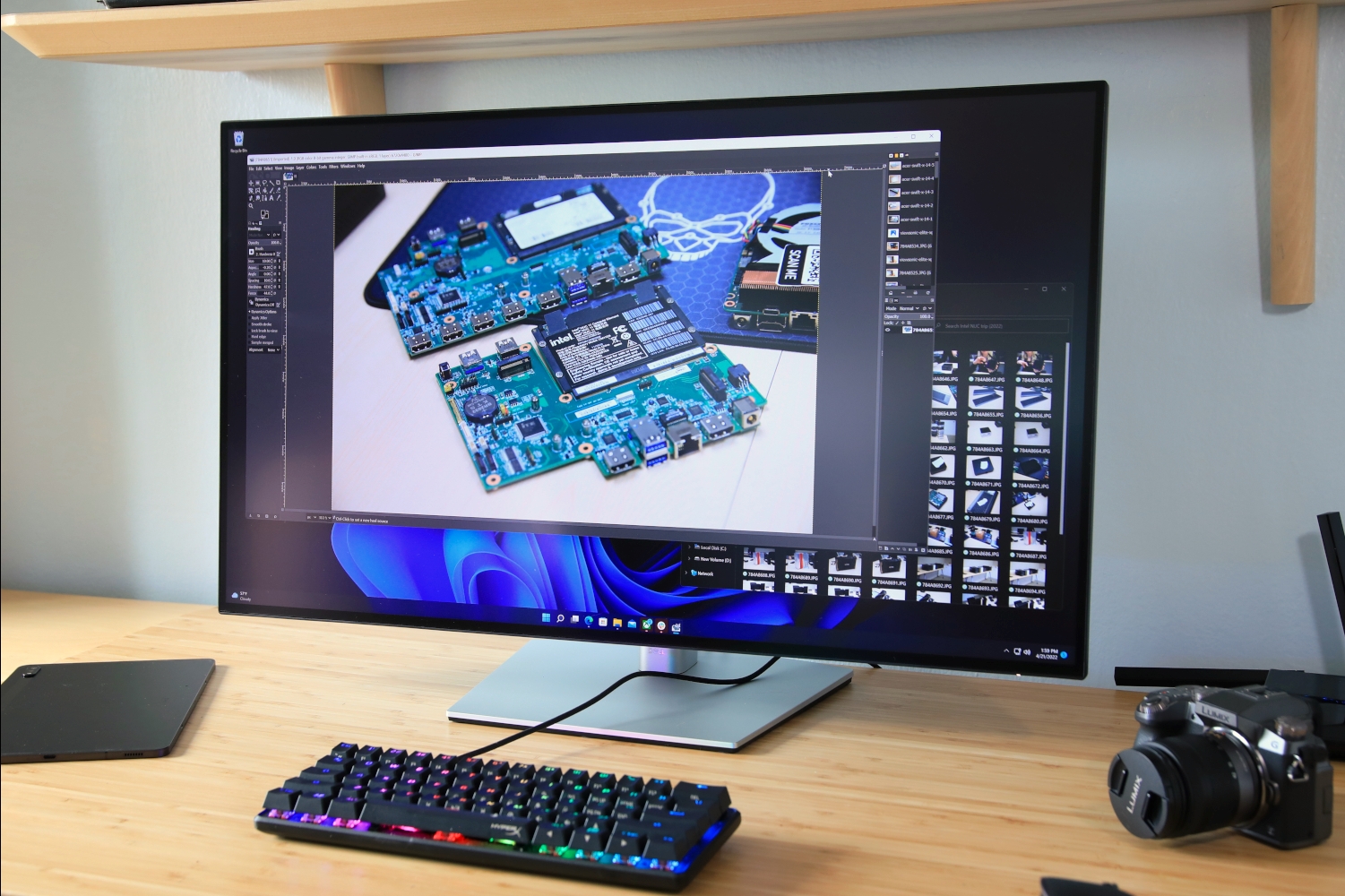Expert's Rating
Pros
- IPS Black panel improves contrast ratio
- Excellent color gamut and accuracy
- Sharp 4K image
- USB-C connectivity with Power Delivery, DisplayPort-Out
Cons
- Generic design
- Awkward on-screen menu system
- Lackluster HDR, 60Hz refresh rate
Our Verdict
The Philips Creator Series 27E2F7901 delivers the benefits of IPS Black and USB-C connectivity while undercutting competitors on price.
Best Prices Today: Philips Creator Series 27E2F7901
LG introduced its new IPS Black panel, which first appeared in the Dell U3223QE and U2723QE, in early 2023—at relatively high pricing. The Philips Creator Series 27E2F7901 takes that same IPS Black panel but cuts pricing by roughly $100. Budget-conscious shoppers must make a few tradeoffs for the lower price, but they don’t take away from Philips’ value.
Further reading: See our roundup of the best 4K monitors to learn about competing products.
Philips Creator Series 27E2F7901: Specs
The Philips Creator Series 27E2F7901’s specifications are nearly identical to competitors like the Dell U2723QE and LG UltraFine 27UQ850-W. Philips provides a 27-inch 4K panel with a 60Hz refresh rate and VESA DisplayHDR 400 certification—just like the alternatives.
- Display size: 27-inch widescreen
- Native resolution: 3840×2160
- Panel type: IPS Black edge-lit touchscreen
- Refresh rate: 60Hz
- Adaptive Sync: VESA Adaptive Sync
- HDR: VESA DisplayHDR 400 Certified
- Ports: 1x HDMI 2.0, 1x DisplayPort 1.4, 1x USB-C with 96 watts USB Power Delivery and DisplayPort Alternate Mode, DisplayPort-out, 4x downstream USB-A, 1x downstream USB-C with 15 watts USB Power Delivery
- VESA mount: 100x100mm
- Speakers: Yes
- Price: $499.99 MSRP
Philips also matches its competition on connectivity. It includes HDMI, DisplayPort, and USB-C. The latter acts as a USB-C hub that powers multiple downstream USB ports. The only port missing is Ethernet, an extra found in Dell’s U2723QE.
Philips Creator Series 27E2F7901: Design
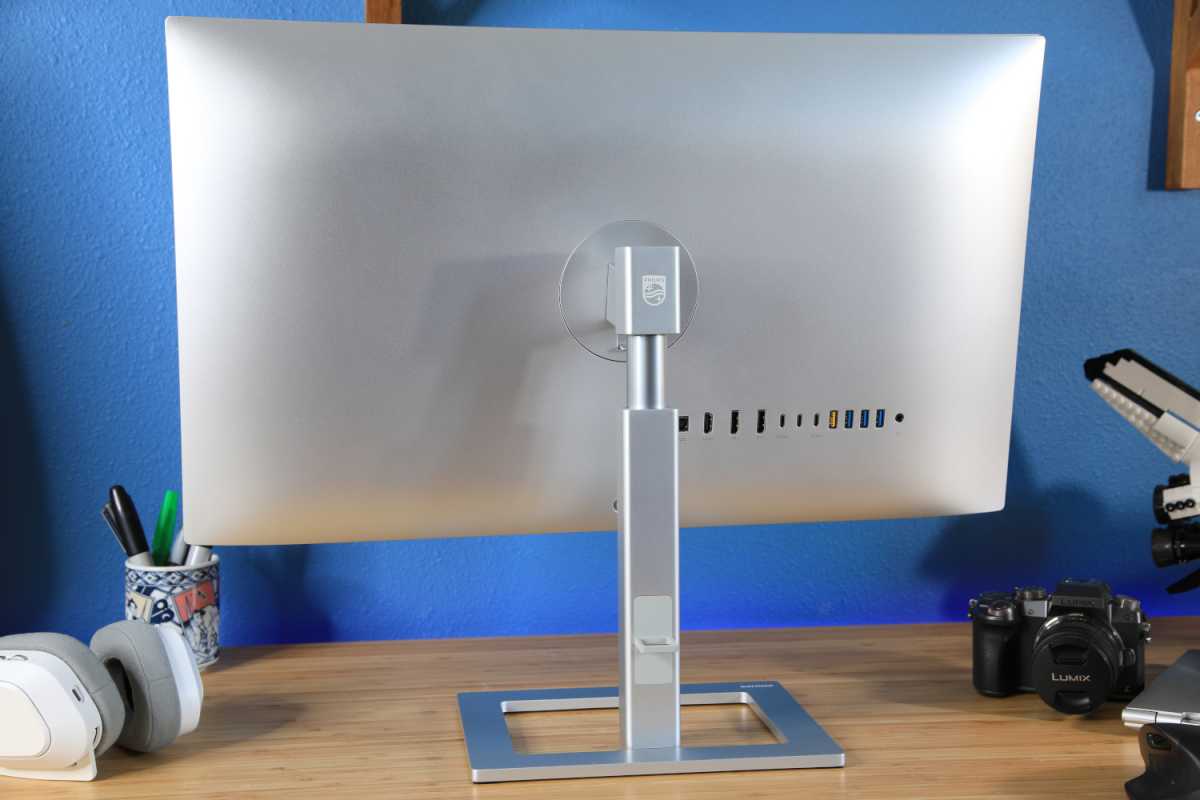
The Philips Creator Series 27E2F7901 is the epitome of utilitarian.
Matt Smith
The Philips Creator Series 27E2F7901, like most monitors designed for productivity, is designed to attract as little attention as possible. It has thin display bezels along all sides which, as a result, provides no space to include even a Philips badge.
There’s more room around back, of course, but here Philips remains committed to inoffensive, generic design. A curved silver plastic panel spans the entirety of the rear. It looks nice but feels inexpensive due to the material’s flat finish. Competitors like Asus and Dell look a tad more premium and feel more durable when handled—but the Philips isn’t bad. It’s merely fine.
The same can be said of the stand. Philips uses a small stand with a flat, rectangular base that minimizes the monitor’s footprint on your desk. The stand supports numerous ergonomic adjustments including height, tilt, swivel, and rotation. However, the stand looks and feels a bit inexpensive, especially compared to hefty stands found on Dell Ultrasharp models.
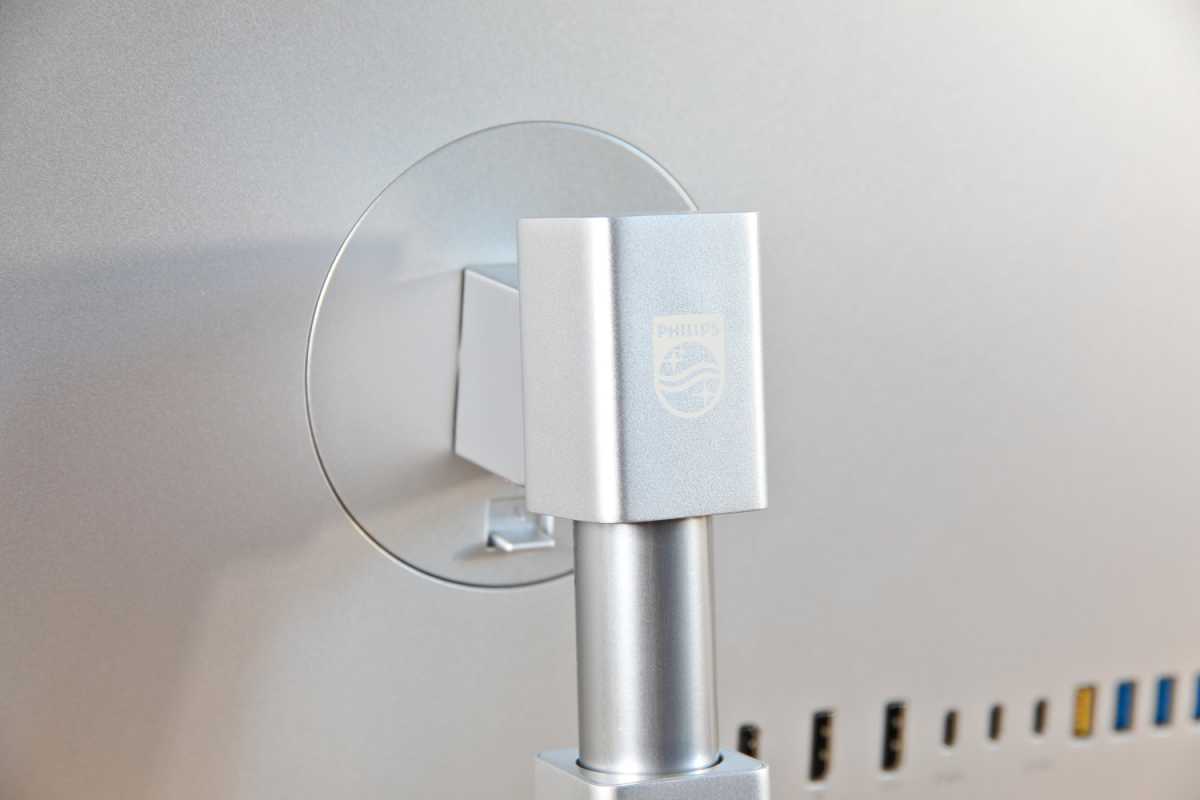
The Philips Creator Series 27E2F7901 supports VESA but comes with its own proprietary mount clip.
Matt Smith
In an unconventional move, the stand doesn’t support VESA and instead attaches through a smaller, proprietary clip. The monitor remains compatible with VESA 100x100mm mounts, but an included VESA bracket must be used. It’s only a minor inconvenience, and the monitor remains compatible with third-party monitor stands and arms.
Philips Creator Series 27E2F7901: Connectivity and menus
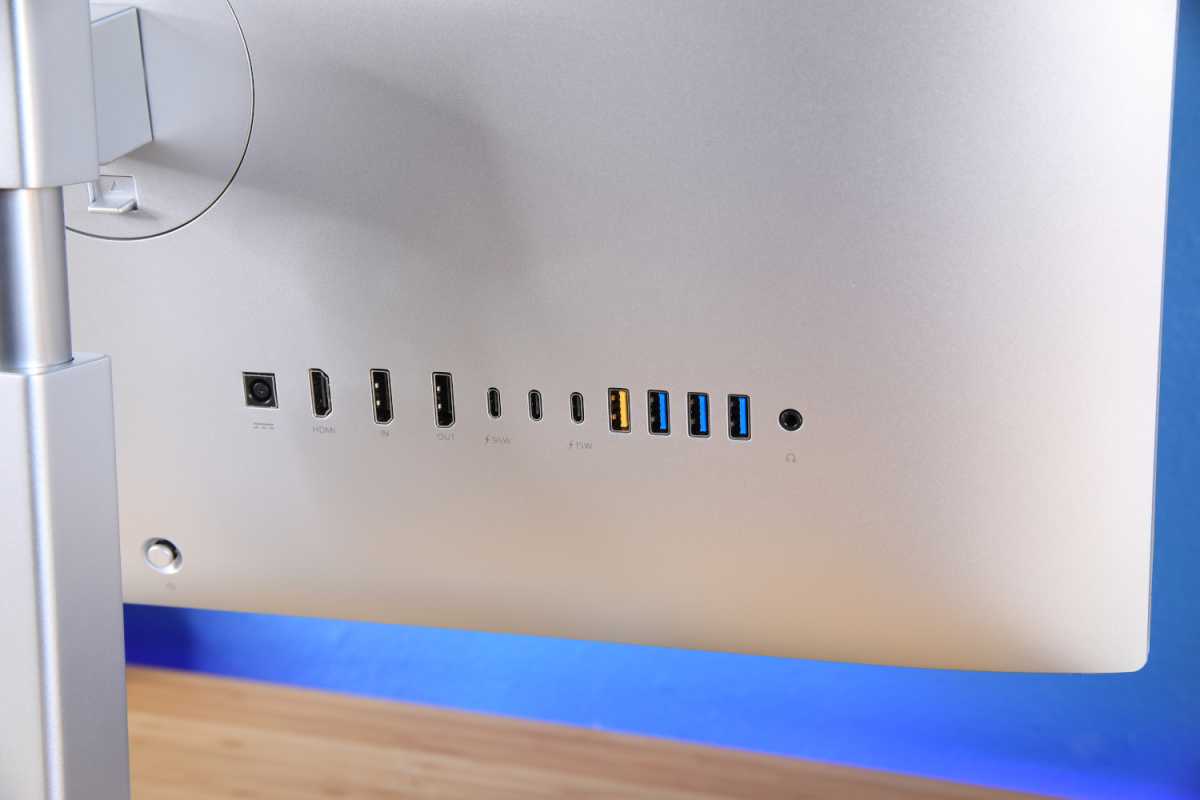
Philips Creator Series 27E2F7901’s connectivity and ports.
Matt Smith
Philips packs impressive connectivity in the Creator Series 27E2F7901. It has three video inputs: one HDMI 2.0, one DisplayPort 1.4, and one USB-C with DisplayPort Alternate Mode. The monitor also includes DisplayPort-out, which means the monitor can “daisy chain” a DisplayPort connection to a second monitor. That’s useful if you want to use multiple monitors with a PC that has just one DisplayPort video output.
USB connectivity is strong. The USB-C port drives four downstream USB-A 3.2 ports and a USB-C port. The monitor includes a KVM switch feature as well, which can be used with two of the USB-A ports. There’s no USB-B upstream port, however—your PC must have USB-C to access the monitor’s USB hub.
Both USB-C ports have USB Power Delivery. The USB-C video input supports up to 96 watts of Power Delivery, which is enough to power many creator laptops including Apple’s MacBook Pro 16 and most Windows laptops without discrete graphics. That makes for an easy, single-cable charging and docking solution. The USB-C downstream port, meanwhile, has 15 watts of Power Delivery. That can be handy for charging a smartphone or tablet.
I want to underscore this point: Philips’ connectivity is excellent. It’s nearly a match for Dell’s U3223QE and U2723QE, though those alternatives add Ethernet. You’ll be hard pressed to find better connectivity at this price point, and that makes the 27E2F7901 a standout choice if you want a monitor that also works as a docking solution for a laptop.
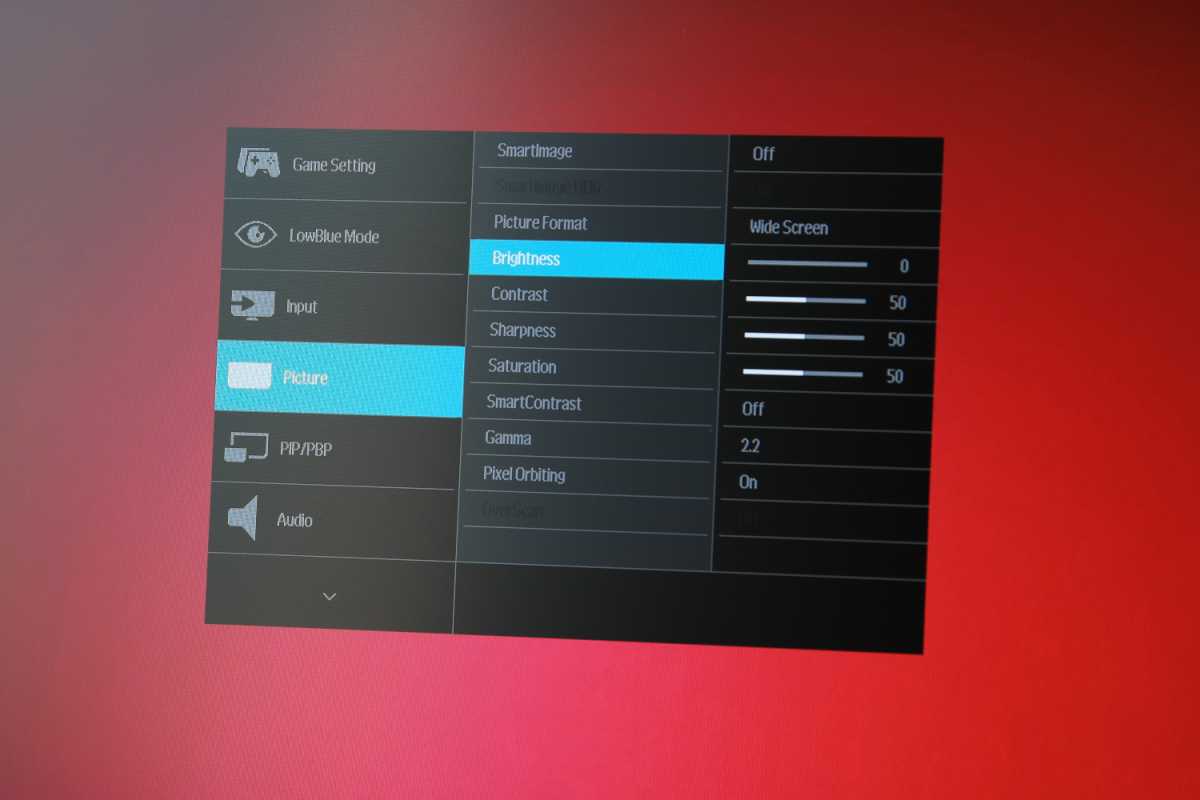
Philips Creator Series 27E2F7901’s on-screen menu.
Matt Smith
Unfortunately, the on-screen menu system is a disappointment. A responsive joystick is provided for quick access to the menus. It works well, but the layout of menus is a problem. Opening the main menu presents Game Settings as the default—a bizarre choice given the monitor’s focus on productivity. Accessing useful features, like Input and Picture, requires several additional steps.
The menu also has a tendency to rotate the orientation of menu inputs and on-screen menu elements 90 degrees. The Brightness setting, for example, is shown as a horizontal bar that scrolls left to right, but adjustments are made by moving the joystick vertically up and down. It’s as confusing as it sounds.
Troublesome menus aside, there’s a decent range of features on offer. Philips offers a wide range of color gamut presets, like sRGB, DCI-P3, AdobeRGB, and Rec.2020. Three-axis color calibration and several Gamma presets are available, too.
Speakers aren’t included. That’s a very minor disappointment: They’re nice to have for basic system sounds, but built-in speakers rarely impress. The monitor includes a 3.5mm audio-out jack that can pass audio to a wired headset or speakers.
You’ll be hard pressed to find better connectivity at this price point, and that makes the 27E2F7901 a standout choice if you want a monitor that also works as a docking solution for a laptop.
How is the Philips Creator Series 27E2F7901’s SDR image quality?
Image quality is always important, but it’s especially important for a monitor like the Philips Creator Series 27E2F7901. It’s meant to handle both day-to-day productivity, like email and Word, and more demanding content creation, like photography and digital art. That requires a wide color gamut and good color accuracy. Fortunately, Philips delivers.
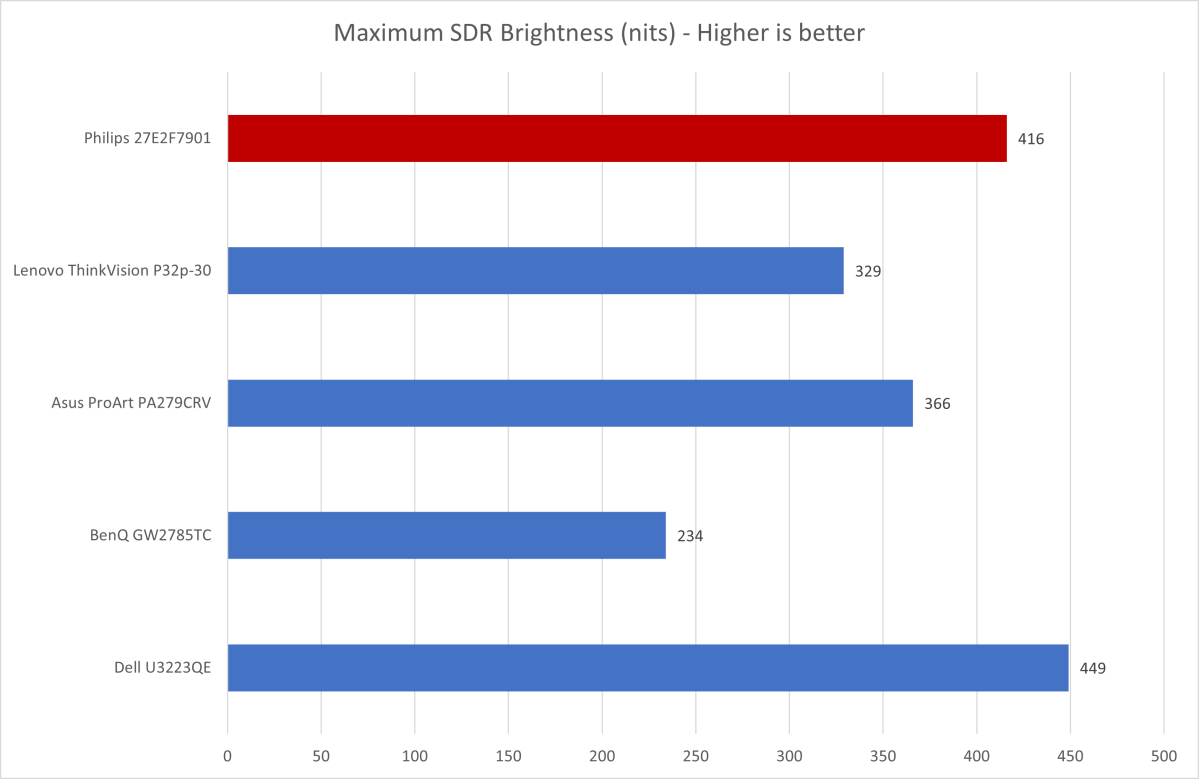
Matt Smith
Brightness starts out strong at a maximum of 416 nits. That’s higher than most comparable monitors and only slightly behind the Dell U3223QE. A maximum brightness beyond 400 nits is overkill for most situations but can prove handy in extremely bright environments, like a downtown corporate office with floor-to-ceiling windows. The monitor also has a semi-gloss finish, so glare is rarely an issue.

Matt Smith
The Philips 27E2F7901 crushes it in contrast with a maximum ratio of 2290:1. Credit the monitor’s IPS Black panel, a new type of IPS panel produced by LG. I praised it when I reviewed the Dell U3223QE, which also has an IPS Black panel, and I remain impressed. The added contrast provides a better sense of depth and dimensionality that’s noticeable in video, photos, and games.
It’s still not perfect. A contrast ratio of 2290:1, though excellent for this category, falls woefully short of the infinite contrast ratio provided by OLED and Mini-LED monitors. The Philips still suffers “IPS glow,” a common flaw visible as a hazy gray sheen to dark content, but the issue is greatly reduced. It’s only distracting when the monitor is used in a very dark room.
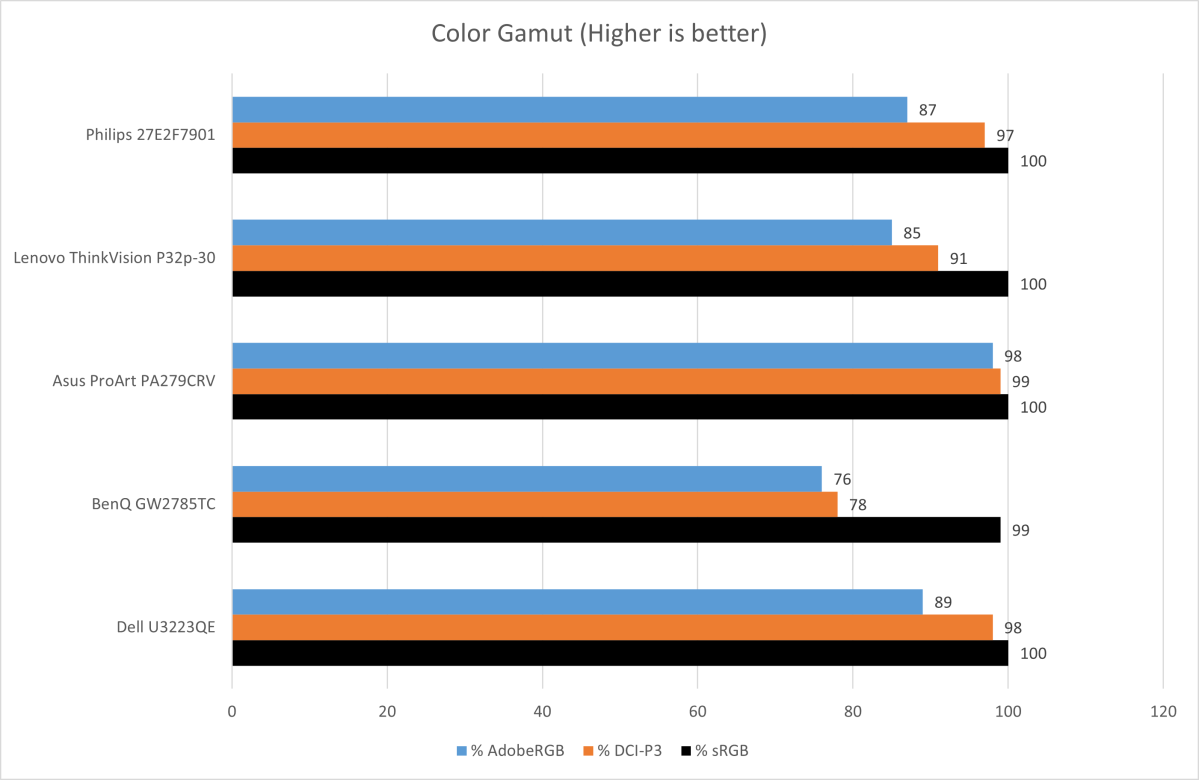
Matt Smith
Color gamut provides more good news, as the monitor is able to produce 100 percent of the sRGB color gamut, 97 percent of DCI-P3, and 87 percent of AdobeRGB. These are high figures and comparable to the Dell U3223QE—no great surprise, as the Dell uses the same IPS Black panel.
Asus’ ProArt PA279CRV is even better, however, as it hits 99 percent of DCI-P3 and 98 percent of AdobeRGB. This is a notable difference, and one that content creators should consider—it might be inadequate if you work in an industry where the AdobeRGB color space is frequently used as the standard. Still, the Philips’ result is strong and up to the needs of most people.

Matt Smith
The same is true of color accuracy, where Philips provided an average color below 1.0–an excellent result comparable to other high-end productivity monitors. The default color error will be difficult to notice. The Philips doesn’t have a significant edge here, as the difference between it and the Lenovo ThinkVision P32p-30 and Dell U3223QE is inconsequential—but this remains a great result.
Philips went a bit astray in color temperature and gamma. I recorded a default color temperature of 6800K, which is a bit cooler than our target of 6500K. The default gamma came in at 2.1, off our target of 2.2, and indicates content will appear ever-so-slightly brighter than it should. Neither value is way off-base, and in many cases the difference might be hard to notice. The monitor also provides image quality customization options to dial in these figures. Still, I’d prefer to see a monitor sold for “content creation” hit these marks by default.
Sharpness, on the other hand, is excellent. The Philips 27E2F7901 is a 4K monitor with 3840×2160 resolution across a 27-inch widescreen panel. That works out to an excellent pixel density of 163 pixels per inch—a huge upgrade over 1080p, which delivers 82 pixels per inch in a 27-inch monitor. Better pixel density can only be found in exotic, expensive monitors like Dell’s 6K U3223KB, which retails at $2,399.99.
The Philips’ 27E2F7901’s overall image quality is great for the price. It delivers on sharpness, color performance, brightness, and contrast. This is as good as image quality gets at $500—those looking for better performance will need to upgrade to a more expensive Mini-LED or OLED alternative.
How is the Philips Creator Series 27E2F7901’s HDR image quality?
The Philips Creator Series 27E2F7901 supports HDR10 and carries VESA DisplayHDR 400 certification but, like most monitors in its category, it fails to deliver a quality HDR experience.
Brightness is a problem. I measured a maximum sustained HDR brightness of 392 nits, which is slightly below the monitor’s SDR brightness. The lack of luminance is a problem, as HDR content is meant to provide an improvement in luminance detail (most HDR content is mastered for at least 1,000 nits of brightness). The Philips isn’t up to the task of displaying these details, which are lost in a bright, uniform sheen.
None of this is unexpected. No monitor sold at $500 or below provides a quality HDR experience. Still, you should know what you’re getting into. Philips supports HDR, but SDR is the focus.
How is the Philips Creator Series 27E2F7901’s motion performance?
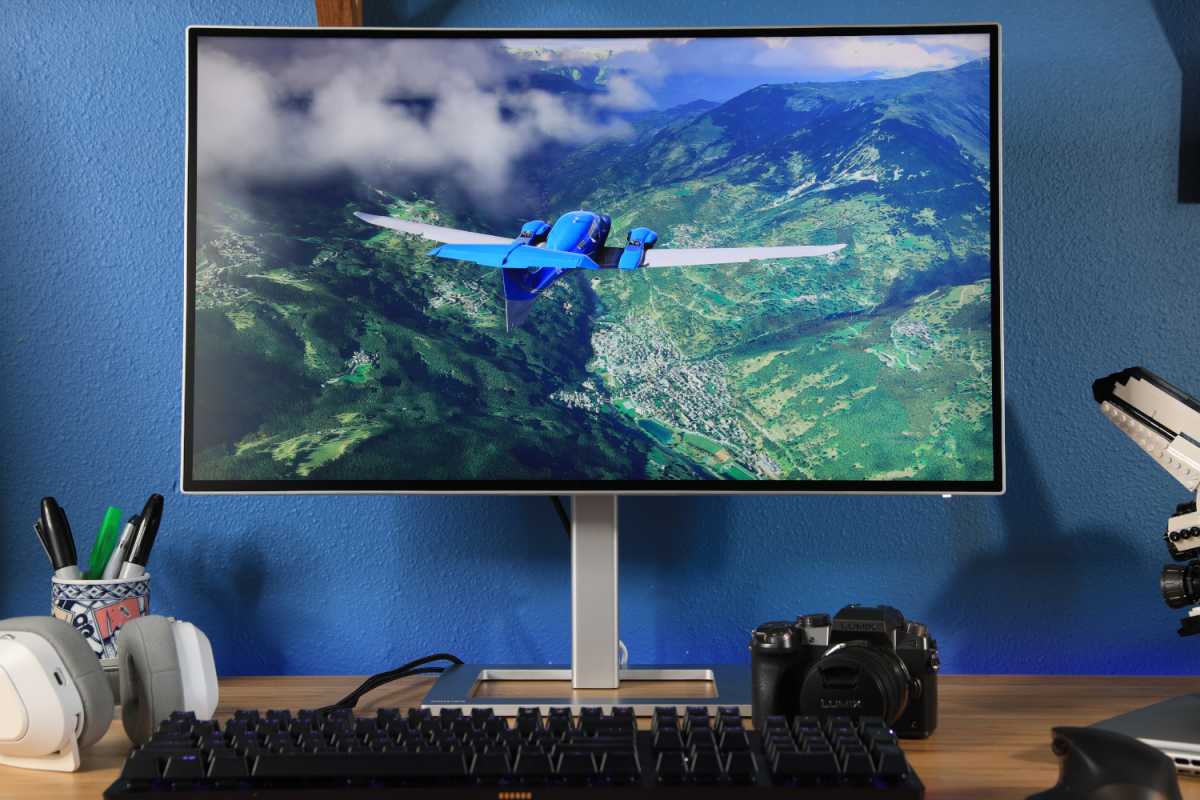
With a 60Hz refresh rate, the Philips Creator Series 27E2F7901 is made more for content creation rather than gaming.
Matt Smith
The Philips Creator Series 27E2F7901 sticks to the standard 60Hz refresh rate. It advertises Adaptive Sync support, which is listed in the menu, but the monitor’s adaptive sync functionality didn’t work with AMD FreeSync.
That’s bad news for gamers. Fast-moving objects show significant blur and quick camera pans will obscure many details of the image. Motion feels reasonably smooth at 60Hz but, compared to a 120Hz or 240Hz monitor, it seems a bit sluggish. This is true of all similar productivity and content creation monitors, however—even those sold at much higher prices.
Should you buy the Philips Creator Series 27E2F7901?
Philips’ Creator Series 27E2F7901 is a good choice if you want a monitor with extensive connectivity and excellent image quality at a modest price tag. Philips undercuts competitors like the LG 27UQ850-W and Dell U2723QE, both of which also have an IPS Black panel, without sacrificing image quality or USB-C. Philips’ design is more generic, and its on-screen menu system is annoying, but these flaws are an acceptable trade-off for pricing that’s typically at least $100 below the competition.




